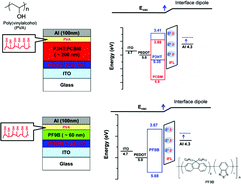Enhancing the efficiency of opto-electronic devices by the cathode modification†
Abstract
A non-conjugated polymer with a polar hydroxyl group as a side group, poly(vinyl alcohol) (PVA), is applied to polymer solar cells (PSCs) and polymer light-emitting diodes (PLEDs) as a buffer layer at the active layer/cathode interface. The best power conversion efficiency (PCE) of PSCs with the PVA film as a cathode buffer layer is 3.27%, which is a 27% increase compared to that of PSCs without the PVA film (2.58%). The PCE improvement is due to enhancement of the short circuit current, the fill factor, and the open circuit voltage, simultaneously. Also, the performances of polymer light-emitting diodes with the PVA film as a cathode buffer layer are better than those of the devices without PVA. Improvement of the performances of the devices is due to the fact that the PVA film reduces a Schottky barrier by the formation of favorable interface dipoles and improves the interface properties.


 Please wait while we load your content...
Please wait while we load your content...